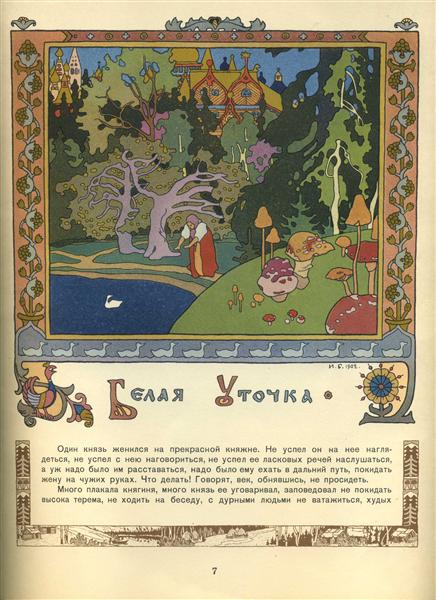Description
The illustration for the Russian fairy tale "White Duck" - 1902, created by Ivan Bilibin, is a penetrating window to the delighted world of Russian popular stories. Bilibin, one of the most prominent illustrators and scenographs of the artistic movement known as the Mir Iskusstva (art world movement), is famous for its evocative representations of fairy and legends stories, and this piece is not an exception.
In painting, Bilibin displays a technical mastery and cultural sensitivity that manages to transport the observer to the heart of the Slavic narrative. In the foreground, the work presents the central figure of a man in a venerable attitude, sitting and dressed in a richly decorated clothes. The details in their clothing not only indicate their status, but also reflect the intricate Russian textile tradition. The floral and geometric motifs in their clothing are characteristic of popular embroidery, and the use of gold suggests a connection with the divine or real, elements commonly found in the stories of Russian fairy.
The environment is a leafy forest that extends to a horizon populated by robust trees, achieving an atmosphere of mystery and mysticism. The trees, with their dark trunks and dense foliage, create a visual contrast that directs the look towards the central character. The peaceful waters of the lake that are glimpsed to the background not only add a sensation of calm, but are also a recurring element in transformation and magic stories.
Bilibin shows a remarkable ability to use color and line so that they not only complement the narrative, but also enrich it. Clear lines and precision outlines are distinctive characteristics of their style, which is often inspired by Russian medieval artistic traditions and illuminated manuscripts. The colors are both vibrant and subtle, creating a captivating contrast that enhances the dream atmosphere.
It is fascinating to observe how Bilibin integrates architectural elements at the bottom of the work, with structures that seem to emerge from the trees. These architectural elements, which remember the orthodox churches and the towers of the ancient Russian cities, not only anchor the scene in a tangible reality, but also reinforce the connection with Russian heritage and history.
The illustration is not only a work of visual art, but also a window to the rich oral and written tradition of Russia. Bilibin, with its acute understanding of the narrative and its ability to capture the essence of myths and legends, takes the viewer on a visual trip that is both a feast for the eyes and a deep appreciation of Russian culture. This particular work stands out for its ability to combine visual and narrative elements in a harmony that is both captivating and reflective.
In the context of his time, Bilibin was part of a cultural elite that sought to rediscover and revitalize national roots through art. "Pato Blanco" is a testimony of this mission, showing how ancient traditions can be reinterpreted and presented to a modern audience, without losing its essence or its original magic.
In conclusion, the illustration for the Russian fairy tale "Pato Blanco" is a masterpiece that reflects the passion of Ivan Bilibin to capture and perpetuate Russian mythology. His artistic ingenuity, combined with a deep understanding of visual narrative, makes this painting an essential piece for the study and appreciation of Russian art and its cultural traditions.
KUADROS ©, a famous paint on your wall.
Hand-made oil painting reproductions, with the quality of professional artists and the distinctive seal of KUADROS ©.
Art reproduction service with satisfaction guarantee. If you are not completely satisfied with the replica of your painting, we refund your money 100%.

